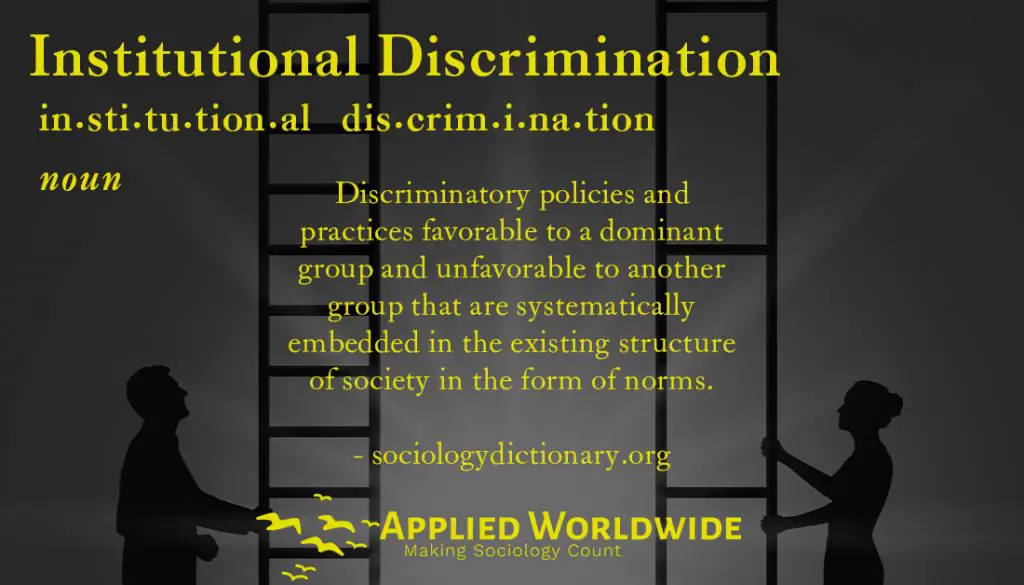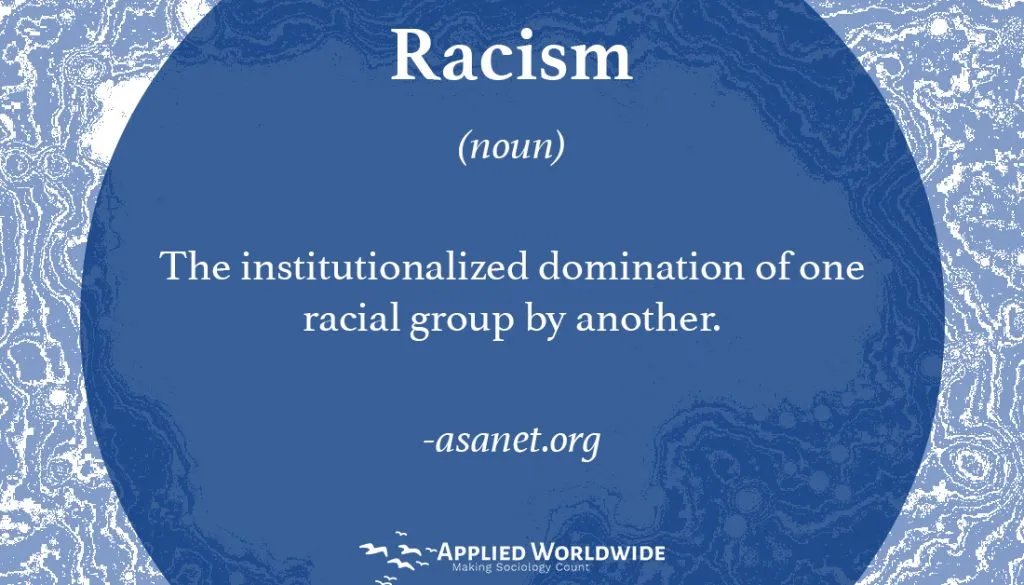Reverse Racism is the idea that discrimination can be directed toward members of a dominant racial group. In the United States, that group is, and has always been, white folks. While the word discrimination is used frequently in everyday conversations, in sociology and other scientific settings it has a distinct meaning. Further, to someone who has not read the research first hand, or who does not have access to academic journals, the claim that white people do not experience racial discrimination can seem bold and unjustified.
In this article, I cover the definition of discrimination from a social scientific perspective along with the research on racial discrimination in hiring practices, healthcare, the criminal legal system, housing, and education. In doing so, I illustrate how sociology dispels the myth of reverse racism.
Prejudice vs. Discrimination
First, let’s cover the difference between prejudice and discrimination. Prejudice, in sociological terms, refers to negative attitudes. Discrimination, on the other hand, refers to negative behaviors. Therefore, discrimination takes prejudice one step further by acting on those negative attitudes. With that said, can someone hold prejudice against white people? Of course. Can someone discriminate against a white person because of their race? Absolutely.
So, then how is reverse racism a myth?
When sociologists talk about discrimination, they are referring to a specific kind—institutionalized discrimination. Institutionalized discrimination refers to “the discriminatory policies and practices favorable to a dominant group and unfavorable to another group that are systematically embedded in the existing structure of society in the form of norms.” In other words, rather than relying on anecdotal experiences to analyze discrimination, sociologists look at aggregate experiences in the form of data. If discrimination occurred at random and was not at least partially determined by race, experiences of discrimination, when analyzed in aggregate, would not show patterns based on race. Yet, the data sociologists analyze often show patterns of racism.

Sociologists also lean on the evidence of institutional discrimination to define racism. Racism, in scientific terms, is “the institutionalized domination of one racial group by another.” Take notice of the word institutionalized. When racism comes up in scientific discussions and studies, the focus is on institutionalized practices and norms that uphold the domination of one racial group by another, not individual behaviors.
All that said, while individuals can hold prejudice and discriminate against other individuals or groups based on race, is it the institutionalized racial discrimination that determines life chances and outcomes. However, it is still important to recognize that racist attitudes and behaviors at the individual level help uphold racist institutional practices and norms. So, while individual attitudes and behaviors are not what define racism in the social sciences, they do play an important role in how racism operates and is able to persist.

Racial Discrimination in Sociology
Racial discrimination has been an area of study in sociology since W.E.B. DuBois began publishing his sociological writings at the turn of the 20th century. Over the last century, sociological perspectives on racial discrimination have evolved to culminate a collection of diverse research that shapes how we see racism today. From statistical analyses of observational data, to ethnographic research, field experiments, and more, sociologists have brought their diverse set of research methods together to study how racial discrimination plays out in a myriad of institutions and organizational settings.
1. Hiring Discrimination
One of those settings is the labor market and, specifically, hiring practices within the labor market. When discussing studies on racial discrimination in hiring practices, one name in particular comes to mind—Devah Pager.
Late sociologist Dr. Devah Pager’s research on hiring discrimination has been cited thousands of times due to both its inventive research methods and stark findings. By approaching her research with experimental methods and audit studies, Pager was able to isolate the cause of different variables, such as race, on hiring outcomes.
Pager’s studies often took the form of sending mock resumes to employers for real job openings where only the race or criminal record differed between applicants. For example, employers would receive two identical resumes, one of which signaled a Black candidate and the other a white. Then, Pager measured certain outcomes such as the the percentage of call-backs based on race.
Pager’s Most Famous Sociological Work
Some of Pagers most famous work uniquely dissects the issue of racial discrimination in hiring practices within the era of mass incarceration. To do so, she measured the effect of both race (Black or white) and a criminal record on the percentage of call-backs for job applicants. Her findings show drastically different outcomes for Blacks and whites with criminal records. Fourteen percent of Black applicants without a criminal record in her study received a call-back compared to 34% of white applicants without a criminal record. Taking the criminal record into account, 17% of whites with a criminal record received a call-back compared to 5% of Blacks.
That means that white applicants with a criminal record outperformed Black applicants without a criminal record, showing a stark difference in the treatment of white and Black applicants during hiring practices. Pager’s line of research, along with the many other sociological studies that echo her findings, show that hiring practices favor white Americans.
2. Racial Health Disparities
Health is another area where discrimination can, and does, result in disparate outcomes based on race. David R. Williams is one sociologist who has spent much of his career studying racism and health. If we look at one measure of health, life expectancy, we can easily observe racial disparities. The average life expectancy for Black Americans as of 2021 was roughly six years shorter than that of the average white American. We can also see racial health disparities by measuring more specific health outcomes like maternal mortality, which is—on average—nearly three times higher for Black women compared to white women in the US.
One line of research from Williams examines the link between residential segregation and racial health disparities. In that research, the relationship between race and economic opportunities plays an important role, indicating that racial discrimination in other areas of life—such as the labor market—has a major impact on health outcomes.
While income and labor market outcomes partly determine residential segregation, race perhaps determines it even more so thanks to America’s history of redlining. Which neighborhood you live in can have an impact on your health through multiple factors, such as:
- environmental pollutants,
- access to fresh produce and other healthy foods,
- proximity to quality health care services, and
- access to quality education.
Importantly, residential segregation provides just one example of how race can determine health outcomes. Other forms of racial discrimination at both the interpersonal and institutional levels, are linked to racial health disparities making it what sociologists call a fundamental cause of health inequality. For example, sociological research shows a positive correlation between instances of racial discrimination and levels of stress, which we know accelerates cellular aging. That means those most likely to experience racial discrimination, such as Black Americans, are also aging more quickly and less successfully.
In short, the sociological evidence on racial health disparities and what causes them is yet another example where we see systems generally benefiting white Americans while disadvantaging racial minorities such as Black Americans. Once again, sociological research demonstrates a lack of reverse racism in modern American society.
3. The Criminal Legal System
Racial discrimination in the criminal legal system is not a new topic to most, even those without extensive knowledge in sociology. We generally know that Black Americans make up roughly 38% of incarcerated adults in the US even though they only make up 13% of the general US population. Those numbers tell us that Black Americans are wildly overrepresented in American prisons and jails while white Americans are actually underrepresented. Even more importantly, those numbers do no match reports of criminal involvement or official arrest records, meaning we know these racial disparities cannot be explained by higher levels of criminality among Black adults.
From books like Nicole Gonzalez Van Cleve’s Crook County: Racism and Injustice in America’s Largest Criminal Court to Bruce Western’s Punishment and Inequality in America, sociologists have spent decades documenting and analyzing instances of racial discrimination in our legal system. What they found is evidence of a system that once again benefits white Americans. Let’s remember the results of Pager’s study which shows white job applicants with criminal records favor better than Black Americans with no criminal record in the hiring process. While criminal records may negatively impact job prospects for everyone, they do so even more for Black Americans.
This differential impact of criminal records for Black Americans is just one of many examples of how the criminal legal system upholds racism in a way that disadvantages Black Americans while privileging white Americans.
4. Housing Discrimination
Redlining is perhaps the most infamous example of housing discrimination in US history. After the Great Depression, the Federal Housing Association (FHA) emerged under the National Housing Act of 1934. At that time, government-sponsored organizations—very literally—created maps that flagged predominantly black neighborhoods as “hazardous,” with a goal to standardize mortgage lending and avoid risky lending. These racially motivated practices made it near impossible for Black Americans to receive FHA-backed loans.
It wasn’t until the Fair Housing Act was passed in 1968 that redlining was no longer considered a legal and legitimate practice. While some of the impact of redlining on residential segregation has faded over time, the long-term impact on generational wealth for Black families cannot be overlooked. Homeownership is a strong indicator of wealth. With it having been denied to Black Americans for decades via government-sanctioned practices, it is not hard to imagine the impact redlining had on the Black community’s ability to gain and maintain wealth across generations.
Despite the government outlawing redlining, sociological research from recent decades shows continued housing and mortgage discrimination based on race that favors white Americans. For example, findings from a 2020 quantitative review of racial discrimination trends in the housing market from 1976-2016 demonstrate persistent discrimination over the decades. One finding specifically shows white renters in studies conducted to measure housing discrimination were generally recommended more units compared to Black and Hispanic renters.
The research also shows that Black and Hispanic borrowers are more likely to be denied loans and, when they are granted loans, are more likely to receive high-cost mortgages compared to their white counterparts. All that said, while more overt discriminatory practices like redlining are now outlawed, their legacy lives on through more subtle forms of discrimination that, once again, work in favor of white Americans.
5. Racial Disparities in Education
When reverse racism comes up in relation to education, people usually run straight toward affirmative action policies. The need for affirmative action in education, however, is based on swaths of evidence showing unequal educational opportunities for Black Americans. One example is public school funding. Because public school funding in the US is mostly supported by tax payers in a school’s respective district, funding varies greatly across districts based on tax-payer income. That variation is evident in the fact that the wealthiest 10% of US school districts spend close to 10 times more than the poorest 10%.
Returning to the evidence on housing discrimination and hiring discrimination, it is important to acknowledge that Black Americans are disproportionately represented in low-income neighborhoods. That means predominantly Black schools often receive less funding. Beyond funding and the impact it can and does have on the quality of education, there is also the issue of differential childrearing at school based on race.
Sociologist Annette Lareau’s famous ethnographic study on childrearing in white and Black American families hones this very issue. While the study’s findings focus mainly on social class, we cannot overlook the increased likelihood for Black families to be working-class, rather than middle-class. Hence why this study sparked a large line of literature focused on varied treatment of children based on race in educational settings.
One example from that literature is a 2007 study that found Black girls are perceived as abrasive and aggressive, traits that school teachers often responded to by taming girls’ behaviors to be more “acceptable.” The author of the study asserts this taming of behavior inhibits academic success for Black girls by encouraging them to abandon assertive behaviors that lead to success. Importantly, research shows that these same behaviors are often encouraged for white students, setting them up for academic success.
Demystifying Reverse Racism
People typically use the phrase “reverse racism” to refer to racism against white folks in America. However, sociological research has shown, time and time again, that our social institutions support practices that perpetually benefit white Americans at the determinant of other racial groups—namely, Black Americans. From hiring and mortgage lending practices, to health disparities and educational opportunities, white Americans consistently come out on top.
Unfortunately for those touting the myth of reverse racism, there is no reputable evidence to suggest that racism in the US is perpetuated against white Americans. For those of us dispelling this myth, the evidence against reverse racism is vast and growing every year thanks in large part to sociologists. It should, however, be the hope for all of us that evidence of institutional discrimination based on race continues to decline as we build a more equitable future for all.







